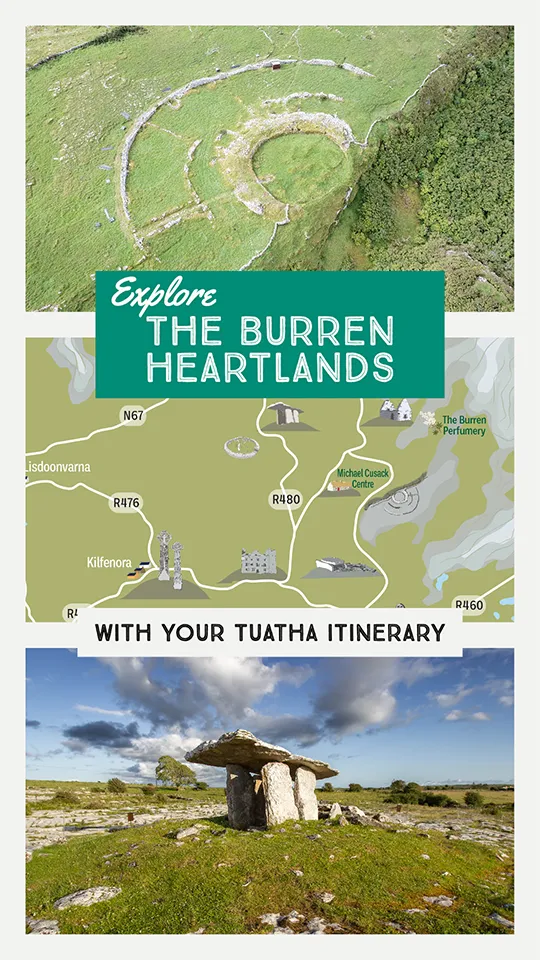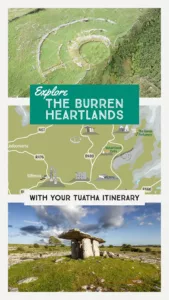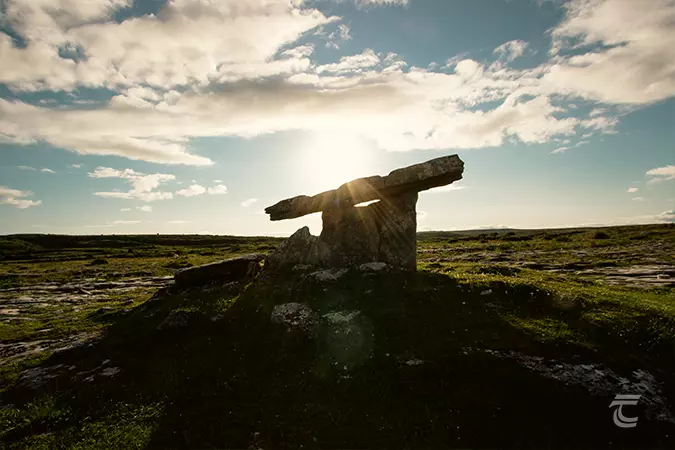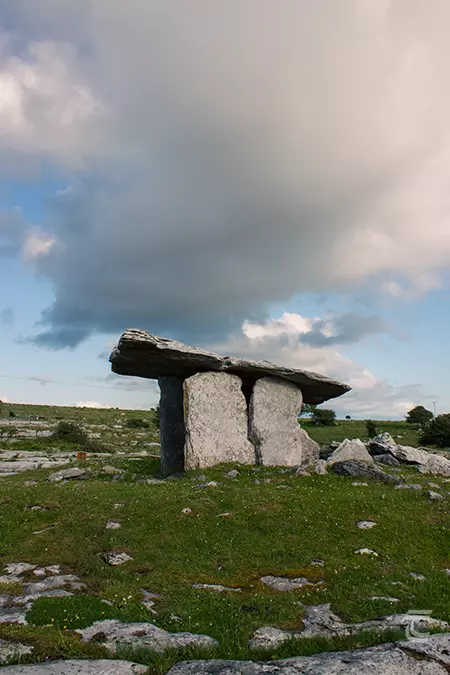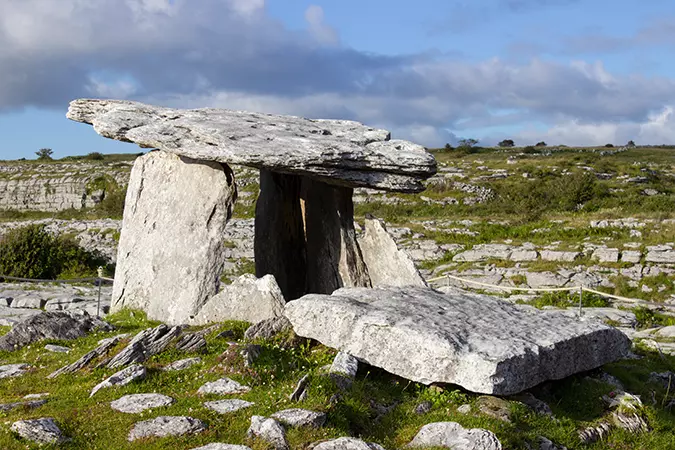Poulnabrone Dolmen
Poulnabrone Dolmen is a portal tomb in the heart of the Burren. Undoubtedly one of Ireland’s most famous megalithic tombs, Poulnabrone was excavated by Dr. Ann Lynch in the 1980s. The excavation came about as part of the effort to conserve the monument, as significant cracks were noticed in one of the side-stones of the tomb. If left untouched, it would have led to the collapse of the monument.
The archaeological excavation of Poulnabrone revealed some remarkable results, that have helped to shed new light on Neolithic Ireland. A range of artefacts were discovered during the dig including a polished stone axe, arrowheads made from chert (a black, flint-like stone), fragments of pottery, beads and pins. Most importantly, the co-mingled remains of at least 36 individuals were recovered from the tomb chamber. They largely ranged in date from c.3800–3200 BC. These people had not been placed whole into the tomb to gently decompose. Instead they had undergone a process of excarnation, which means they had been left elsewhere, possibly in a cave, or even exposed to the elements and wildlife. After that process, parts of the remains would then have been placed in the tomb. Some were unburned, while others had been further ‘cleansed’ by fire. The fragmentary remains were then placed in the chamber of the tomb, while some were pushed down into the cracks (or grykes) in the Burren’s limestone pavement.
For practical information about visiting this site Click Here
Poulnabrone Dolmen is a portal tomb in the heart of the Burren. Undoubtedly one of Ireland’s most famous megalithic tombs, Poulnabrone was excavated by Dr. Ann Lynch in the 1980s. The excavation came about as part of the effort to conserve the monument, as significant cracks were noticed in one of the side-stones of the tomb. If left untouched, it would have led to the collapse of the monument.
The archaeological excavation of Poulnabrone revealed some remarkable results, that have helped to shed new light on Neolithic Ireland. A range of artefacts were discovered during the dig including a polished stone axe, arrowheads made from chert (a black, flint-like stone), fragments of pottery, beads and pins. Most importantly, the co-mingled remains of at least 36 individuals were recovered from the tomb chamber. They largely ranged in date from c.3800–3200 BC. These people had not been placed whole into the tomb to gently decompose. Instead they had undergone a process of excarnation, which means they had been left elsewhere, possibly in a cave, or even exposed to the elements and wildlife. After that process, parts of the remains would then have been placed in the tomb. Some were unburned, while others had been further ‘cleansed’ by fire. The fragmentary remains were then placed in the chamber of the tomb, while some were pushed down into the cracks (or grykes) in the Burren’s limestone pavement.
For practical information about visiting this site Click Here
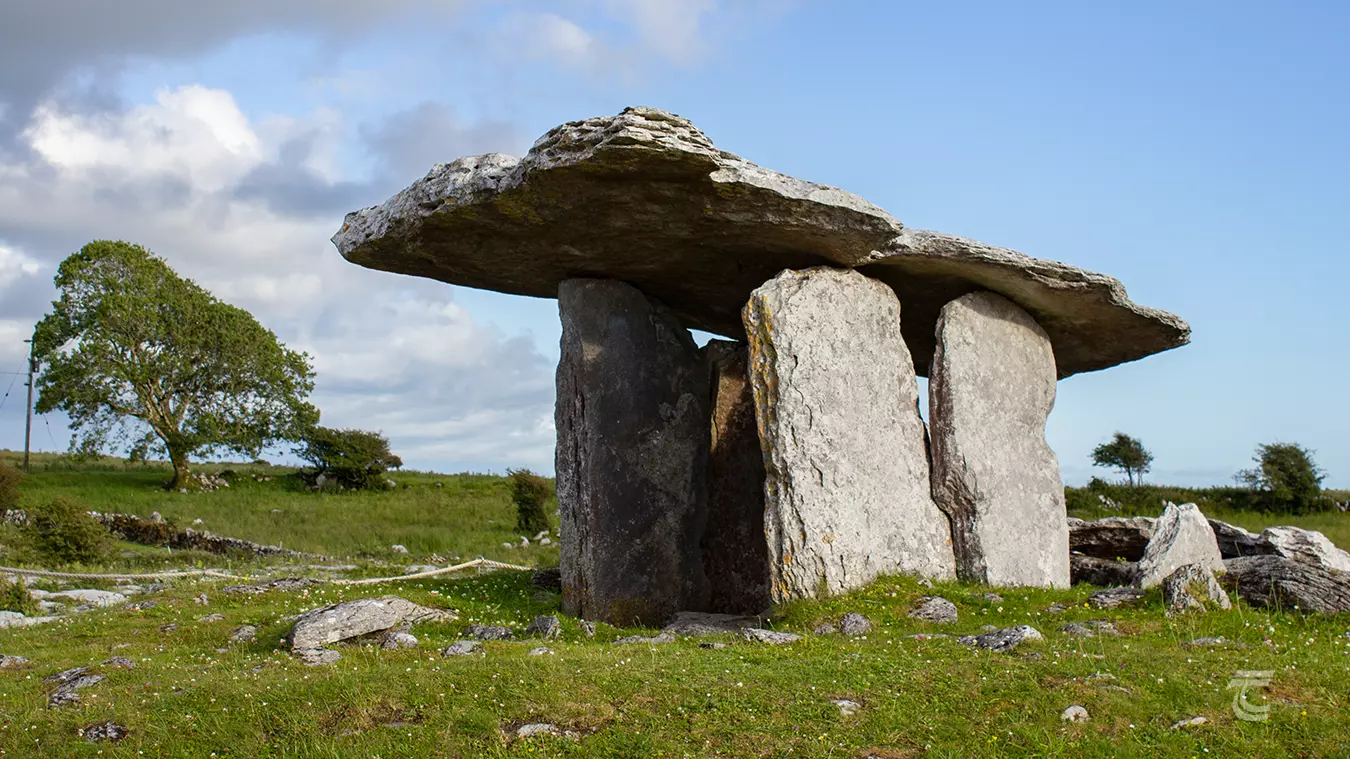
Poulnabrone Dolmen • Clare
The People of Poulnabrone
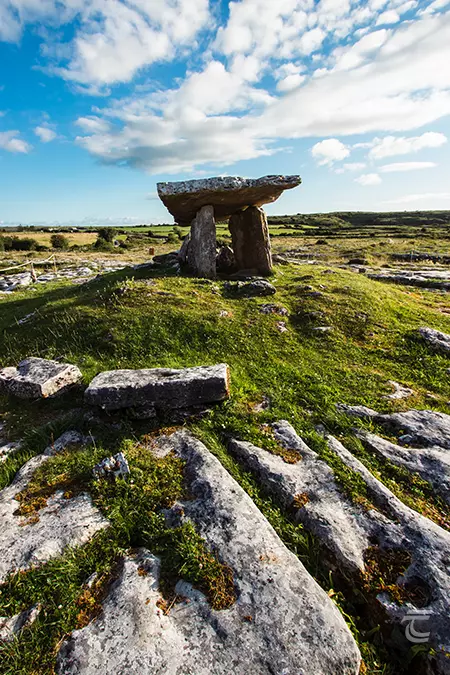
Poulnabrone Dolmen among the Burren’s karst landscape • Clare
Analysis of the human remains produced some remarkable insights. Most of those individuals who could be identified from the fragmentary remains were adults, though only one appeared to have lived past the age of 50. Their bones told a story of hard work and toil, with signs of arthritis and wear and tear. There was also signs of violence. A hip bone of a male had the tip of a stone projectile point, possibly an arrowhead, embedded in it. The analysis revealed that this injury had occurred around the time of death, as there were no signs of healing on the bone.
The oldest person to have been interred in the tomb was a woman, and analysis suggests she lived to around 55 years of age. This was a considerable age in a period long before antibiotics, and a time where childbirth was often highly dangerous. It is tempting to wonder if she was an elder, maybe a matriarchal figure? What was her life like in this almost unimaginably different world?
As well as adults, the analysis also revealed that the remains of five children were interred at Poulnabrone. One of these was a newborn, who was laid to rest in the portico of the tomb in the Bronze Age, centuries after the tomb was first constructed.
Dr. Lara Cassidy of Trinity College Dublin carried out genetic analysis on the remains, and evidence from the inner ear bone of one those children revealed that it belonged to a six-month-old boy with Down syndrome. This is the earliest evidence yet found of Down syndrome in Ireland.
You can read a great article on Poulnabrone by Clodagh Finn in the Irish Examiner, that features Dr Lara Cassidy’s work. If you would like to dig deeper into the story I recommend Dr. Ann Lynch’s book Poulnabrone: An Early Neolithic Portal Tomb in Ireland. Published by Wordwell and available here. Finally you can hear more on the Neolithic treatment of the dead in the Carrowkeel episode of Amplify Archaeology Podcast (also including Dr. Lara Cassidy).

Poulnabrone Dolmen among the Burren’s karst landscape • Clare
Upper left: sunset at Poulnabrone Dolmen • Lower left: the tomb stands in a rock-strewn field • Right: shifting skies over Poulnabrone Dolmen.
Top: sunset at Poulnabrone Dolmen • Middle: shifting skies over Poulnabrone Dolmen • Bottom: the tomb stands in a rock-strewn field
Explore more sites on the Wild Atlantic Way
